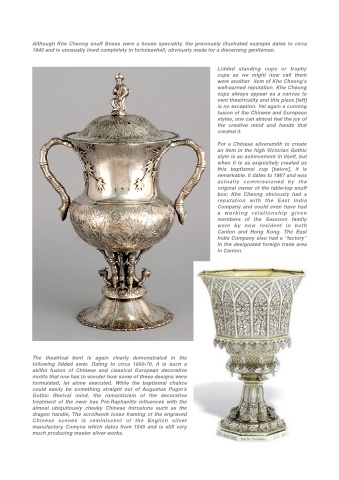Page 399 - Chinese SIlver By Adrien Von Ferscht
P. 399
Although Khe Cheong snuff Boxes were a house speciality, the previously illustrated example dates to circa
1840 and is unusually lined completely in tortoiseshell; obviously made for a discerning gentleman.
Lidded standing cups or trophy
cups as we might now call them
were another item of Khe Cheong’s
well-earned reputation. Khe Cheong
cups always appear as a canvas to
vent theatricality and this piece [left]
is no exception. Yet again a cunning
fusion of the Chinese and European
styles, one can almost feel the joy of
the creative mind and hands that
created it.
For a Chinese silversmith to create
an item in the high Victorian Gothic
style is an achievement in itself, but
when it is as exquisitely created as
this baptismal cup [below], it is
remarkable. It dates to 1867 and was
actually commissioned by the
original owner of the table-top snuff
box; Khe Cheong obviously had a
reputation with the East India
Company and could even have had
a working relationship given
members of the Sassoon family
were by now resident in both
Canton and Hong Kong. The East
India Company also had a “factory”
in the designated foreign trade area
in Canton.
The theatrical bent is again clearly demonstrated in the
following lidded ewer. Dating to circa 1860-70, it is such a
skilful fusion of Chinese and classical European decorative
motifs that one has to wonder how some of these designs were
formulated, let alone executed. While the baptismal chalice
could easily be something straight out of Augustus Pugin’s
Gothic Revival mind, the romanticism of the decorative
treatment of the ewer has Pre-Raphaelite influences with the
almost ubiquitously cheeky Chinese intrusions such as the
dragon handle, The scrollwork loose framing of the engraved
Chinese scenes is reminiscent of the English silver
manufactory Comyns which dates from 1645 and is still very
much producing master silver works.

